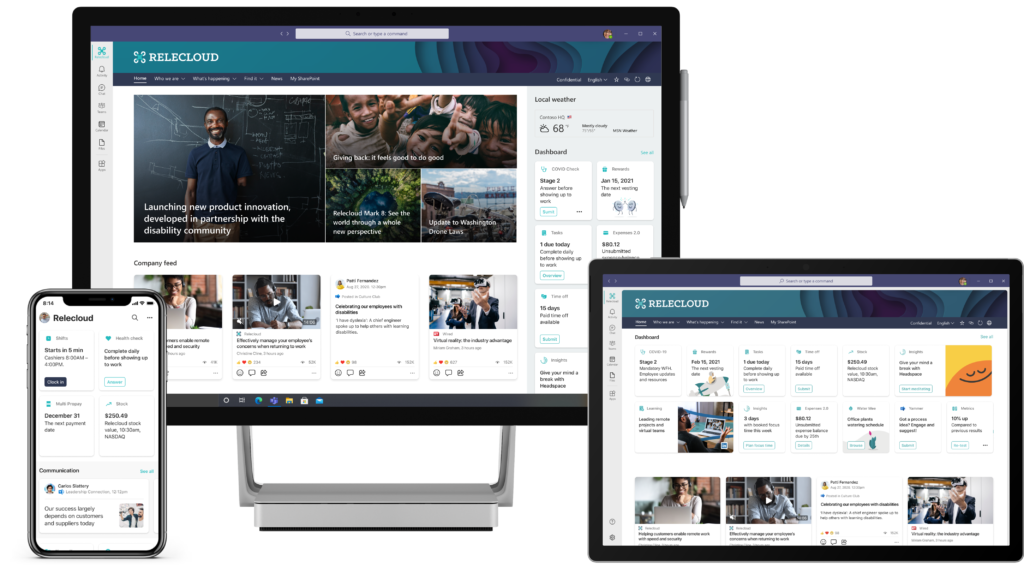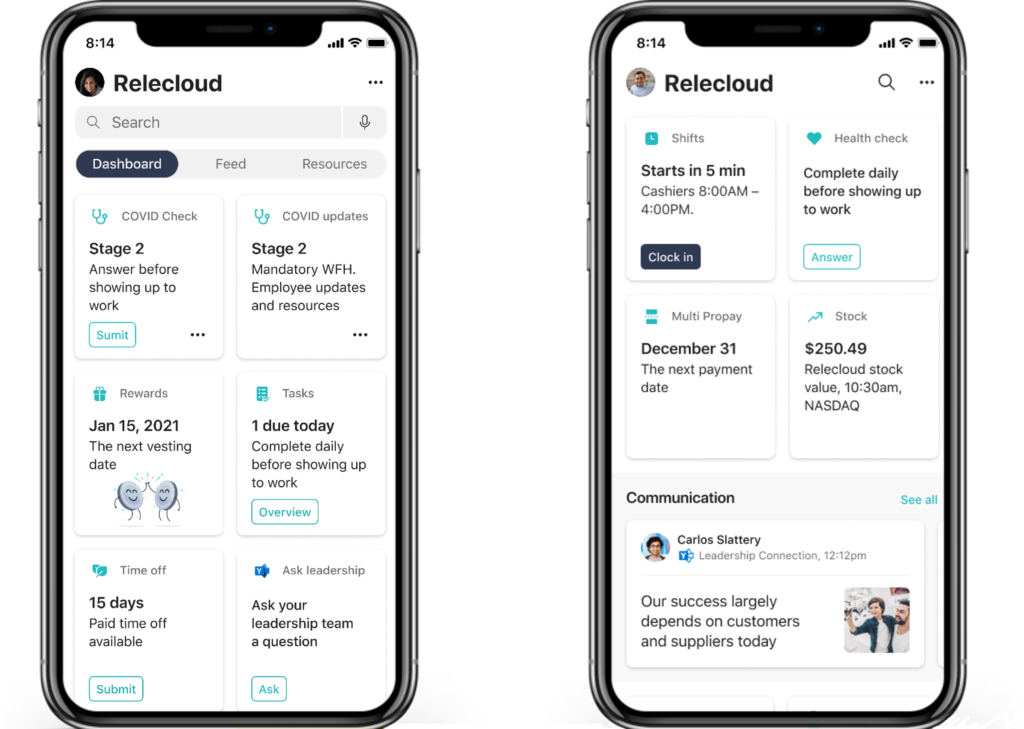
Published 25 October 2022
With intranets now acting as the digital front door for many organisations, it’s important for them to have a strategic focus in your digital employee experience strategy.
During a recent event, we were joined by four industry experts who each shared insights into planning your digital employee experience strategy and how Microsoft Viva can play a pivotal role in your success. Below we cover the key takeaways from this event and why giving your employees a reason to go online is the key to engaging them.

The challenges organisations are seeing in 2022
It would be remiss of us to not mention COVID-19 and the impact this has on working habits. When the world grinded to a halt and working from home orders were implemented, it was the technology that kept organisations going. Microsoft Teams became the saving grace for communication and collaboration, and intranets were the online destination for housing company changes, updates to policies, and the go-to destination for new starters to access onboarding information. The ever-changing working from home orders meant organisations needed to be reactive to the new working habits, leaving no time to proactively plan a strategy that is right for their employees. However, there is good news: that’s changing.
As the digital world has evolved, the ability to think fast and act quick has never been more important. For years, large organisations have had dedicated teams solely responsible for making their customers’ experiences better, but it took the pandemic for leadership teams to ask the question: How can we improve our own employee experience? With the world living online, specifically digital employee experience.
When we talk about digital employee experience it’s easy to assume we mean knowledge workers sitting at desks focused on Microsoft Word (what is this, 1999?) but it’s unlocking tools to engaging your frontline workers where the magic can take a whole new turn.
Throughout the past three years, organisations have worked hard to ensure frontline workers have mobile and remote access, but it’s important to ask why this is important. According to the Step Two DEX report, 51% of people said frontline workers have a poor digital experience which is alarming but sadly not surprising. If your frontline workers have no reason to go online, they will feel disconnected when they do, and their experience is likely to be a negative one. Makes sense, right? By digitising tasks that are fundamental for frontline workers to do their job (checking rosters, swapping shifts, approvals, etc.), it will give them a regular reason to go online, and this will be your key to connecting and engaging them.
Another key challenge we are hearing from our clients is integration with third party applications. When your employees have landed on your intranet, they don’t want to link off to a third-party site where they must remember another username and password; they want integrations that make their workday easy, simplified, and quick. Applications they use in their personal life have these integrations (think signing into streaming services using your Facebook account) and they rightly expect this within their working environment.
As James Robertson joked in our recent event, an intranet is “never trendy but definitely not dead and more important than ever” so it’s important to be strategic in the purpose you want it to fulfil to get its maximum potential.
Using research to plan your digital employee experience strategy
It’s easy to forget that a digital workplace isn’t a destination but is made up of tools and applications. Whether you’re a small company working in Exchange and Word, or a large organisation who has multiple product owners, it’s all part of it.
Many organisations today have a poor digital workplace but it’s not through a lack of technology. There are more tools available that are better than ever, thanks to M365, but there is complexity in bringing in a digital solution for every task. So, when planning your digital employee experience, it’s important to put the human in the picture and remember that it’s not just what’s delivered but how it’s delivered through the devices and the environment your employees are sitting in.
Research plays a key role in the success of planning your digital employee experience strategy. Our best success stories are organisations who have a focused employee experience research phase within their strategy project or stand alone research project before they know what they want to do next. By running research phases, you’ll truly understand your digital landscape better and have the resources to develop a tailored strategy with your employees’ wants and needs, shaping your organisation for the next 2-5 years.
However, it’s important to remember that simply asking your employees want they want is not research. Collating your employees’ feedback and understanding how they work by identifying patterns and pain points is how your research is formed. Your employees aren’t expected to provide the answers to your future – that’s what the experts do.
When in the research phase we recommend running employee surveys, focus groups and 1:1 interviews from across departments and teams, to understand the requirements at an individual level and not just the organisations.
Diving into the following with your employees and analysing their feedback will be key to developing your strategy:
- Understanding your digital landscape
- Understanding the tools on offer
- Challenges users are facing
- Gaps in their digital employee ex
- Understanding digital landscape
- What is each tool used for
- Maturity to technology
- Aspirations to evolving their maturity
The result of doing a research phase and listening to your employees means they feel consulted, included, and most importantly connected to the outcomes of the strategy, which is fundamental to the adoption of the technology and new ways of working.
Where does Microsoft Viva fit into the digital employee experience?
Microsoft Viva launched in 2021 and is an employee experience platform made up of different modules that bring together communications, knowledge, learning, resources, and insights.
Viva Connections is a module of Viva and helps organisations stay engaged and informed with seamless information with a curated experience that includes relevant news, conversations, and other resources – all within your intranet.
Viva Connections is now part of every intranet project Engage Squared delivers, and this is largely due to the out-of-the-box capabilities it offers. Viva Connections meets the mobile access required by most organisations today, the audience targeting and personalised content, but it’s the Dashboard that truly offers change in the intranet space. The Dashboard provides fast and easy-access to information and job-related tasks by using data from Active Directory. Content can be targeted to users in specific roles, markets, and job functions but the best part are the adaptive cards that connect with third party integrations in an intelligent way (remember the integration challenge we mentioned earlier?). We regularly receive feedback from our clients on how this one feature is improving employee productivity by bringing daily tasks into their flow of work and allowing users to perform day-to-day tasks not available through a SharePoint Online intranet.

Viva Connections is all in the name, connection, but before connection comes engagement. A key question posed in the Work Trend Index Report released in September 2022 asked “How do we use the intranet to start connecting people to information, knowledge, communities?”. The answer is bringing personalised experiences into the flow of work so that your employees feel connected to your purpose and mission and your intranet is your space to create that.

Our advice is to plan both your broader digital employee experience and your intranet strategies with Viva Connections and the dashboard as key players because they will be your gateway to a modern experience that employees expect today. The key considerations when planning your strategies include:
- How can an integrated digital space meet our organisational strategic employee experience?
- How can we reduce the complexity across our digital landscape?
- What is the best way to meet our user’s needs in an intuitive way?
Who should own your intranet?
Your intranet will attract attention from every department across your organisation and they will all have an opinion but that’s no bad thing. Having just one person or department owning your intranet will naturally cause bias, so nominating key stakeholders from across departments including IT, Comms, HR, etc. will ensure you are creating a digital space for everyone.
The key thing is to form a group of people full of purpose and passion who act as your organisation’s committee to review upcoming features and changes in the space and understand how this will affect your organisation.
By having a variety of voices heard and working together, you will plan for a future of what your people want.
Measuring success
Building and planning a great digital experience is only the start of your journey. The adoption of your intranet is fundamental to its success, whilst the engagement is crucial to understanding if what you have delivered is what people want. The success of your intranet should no longer be based on how many views a page has, but how connected your employees are to the content that you are offering.
Google Analytics or Adobe Analytics are great measurement tools for tracking public websites but for internal tools the goals are different which is why we partner with SWOOP Analytics who provide collaboration analytics for Microsoft 365. For public facing websites the longer the session the better as users are usually browsing, shopping or absorbing content which is what you want because time = money. However, in your intranet’s case measuring success relates to the audience itself. The news page of your intranet will naturally see employees spending more time as they absorb the information, whereas other pages should be measured based on how quickly a task is performed, the information is found or the collaboration between users.
The governance of how your intranet’s pages are managed should also not be overlooked. The success of your intranet will also feed into how content is kept up to date with the right content at the right time to the right people and that comes back to ensuring you have a committee who is serving its employees.
The key thing when measuring success, is to factor in a tool is as early as you can. If you are at the start of your journey, make sure to include measurement building at the MVP level so you can measure if what you delivered was a success. If you’re reviewing your intranet’s current state, then make sure that you have measurement tools planned within the rollout and if you’re starting from scratch make sure it’s part of your project from day dot.
3 tips for aligning your intranet with your broader digital strategy
The world of digital has only just begun and it’s rare to see anyone having it all figured out. The desire to create a better future is here because digital workplaces are no longer nice to have, they are crucial to performance.
Our 3 tips for aligning your intranet within your broader digital strategy:
- Bring your intranet leaders into the conversation of your wider digital employee experience strategy to align the activities planned with the overarching business strategy
- Put the human at the centre of your strategy. Spend time with your employees and really listen to their ideas. Look at the environments they work in and identify patterns in the feedback they are providing
- Align the wants and needs of employees with your organisation’s strategy and design solutions. By including them, they’ll feel connected and engaged, and you’ll receive great outcomes